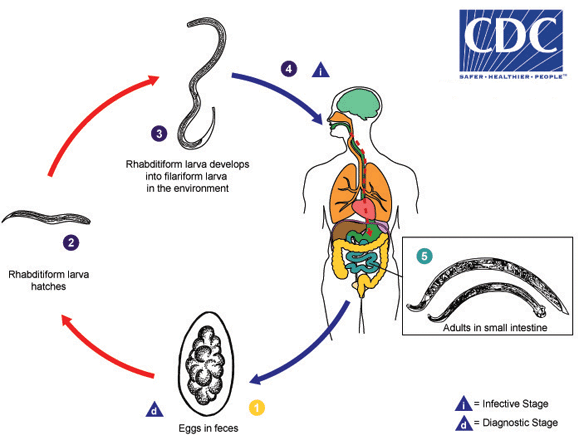
Trichostrongylosis
[Trichostrongylus spp.]
Causal Agents
Nematodes in the genus, Trichostrongylus. Although primarily parasites of animals, several species of Trichostrongylus have been known to infect humans, including T. orientalis, T. colubriformis, and T. axei.
Life Cycle

Eggs are passed in the stool of the definitive host (usually a herbivorous mammal)  , and under favorable conditions (moisture, warmth, shade), larvae hatch within several days. The released rhabditiform larvae grow in the soil or on vegetationl
, and under favorable conditions (moisture, warmth, shade), larvae hatch within several days. The released rhabditiform larvae grow in the soil or on vegetationl  , and after 5 to 10 days (and two molts) they become filariform (third-stage) larvae that are infective
, and after 5 to 10 days (and two molts) they become filariform (third-stage) larvae that are infective  . Infection of the human host occurs upon ingestion of these filariform larvae
. Infection of the human host occurs upon ingestion of these filariform larvae  . The larvae reach the small intestine, where they reside and mature into adults. Adult worms inhabit the digestive tract of their definitive hosts and may occur as incidental infections in humans
. The larvae reach the small intestine, where they reside and mature into adults. Adult worms inhabit the digestive tract of their definitive hosts and may occur as incidental infections in humans  .
.
Geographic Distribution
Worldwide, but more common where livestock is raised.
Clinical Presentation
Most infections are asymptomatic. Heavy infections can cause gastrointestinal problems (abdominal pain, diarrhea, anorexia), headache, fatigue, anemia and eosinophilia.
Trichostrongylus spp. eggs in wet mounts.




Trichostrongyle eggs in wet mounts.



Trichostrongylus adults.




Laboratory Diagnosis
Microscopic identification of eggs in feces is evidence of infection. Because eggs may be difficult to find in light infections, a concentration or flotation procedure is recommended. Patients may have co-infections with hookworm, so care must be taken to differentiate the two.
Treatment Information
For information about treatment please contact CDC-INFO.
DPDx is an educational resource designed for health professionals and laboratory scientists. For an overview including prevention, control, and treatment visit www.cdc.gov/parasites/.